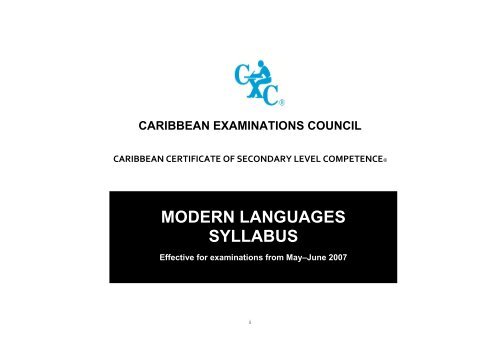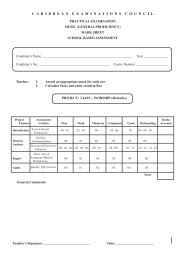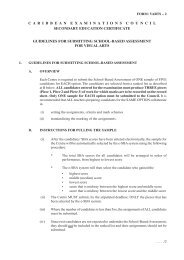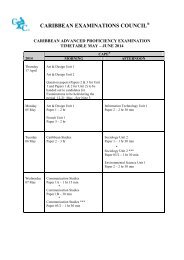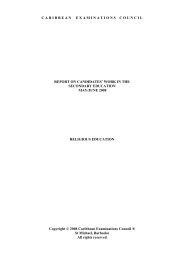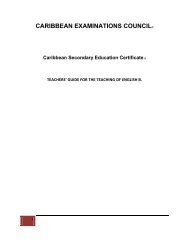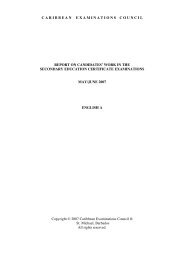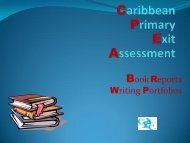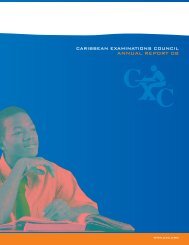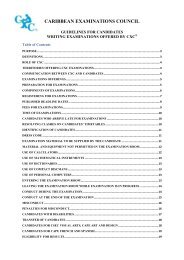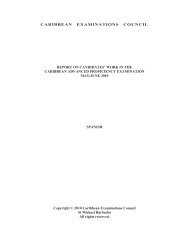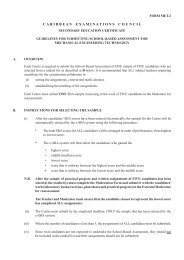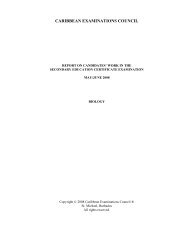CCSLC Modern Languages Syllabus - Caribbean Examinations ...
CCSLC Modern Languages Syllabus - Caribbean Examinations ...
CCSLC Modern Languages Syllabus - Caribbean Examinations ...
- No tags were found...
Create successful ePaper yourself
Turn your PDF publications into a flip-book with our unique Google optimized e-Paper software.
Please note that the syllabus was revised and amendments are indicated by italics and vertical lines.First issued 2006Amended 2012Please check the website, www.cxc.org for updates on CXC’s syllabuses.<strong>CCSLC</strong>/ML/O4/12
ContentsContentsIntroductionINTRODUCTION ................................................................................................................................................................................................................................................………………………….iRATIONALE .......................................................................................................................................................................................................................................................…………………………..1AIMS .................................................................................................................................................................................................................................................................…………………………..1GENERAL OBJECTIVES ......................................................................................................................................................................................................................................………………………..…2COMPETENCIES TO BE ASSESSED ...................................................................................................................................................................................................................………………………..…2ORGANISATION OF THE SYLLABUS ..................................................................................................................................................................................................................………………………..…3RECOMMENDED APPROACHES TO TEACHING THE SYLLABUS .......................................................................................................................................................................……………………….….3ASSESSMENT GUIDELINES ...............................................................................................................................................................................................................................…………………………..4FORMAT OF THE ASSESSMENT ........................................................................................................................................................................................................................………………………..…7MODULE 1 – KNOWING ME, KNOWING YOU - Self, Family, Friends, Neighbours, Pets and Community. ...................................................................................................……………………….….9MODULE 2 – SEE ME ON THE GO - School And Daily Routine ......................................................................................................................................................................…………………………..17MODULE 3 – LET’S LIVE IT UP! - Sports And Leisure, Eating Out, Travel .......................................................................................................................................................………………………….28MODULE 4 – CASH IT OR CHARGE IT? - Shopping ..........................................................................................................................................................................................…………………………..41MODULE 5 – WATCH ME GROW - Occupations, Professions and Future Plans...........................................................................................................................................…………………………..51APPENDIX I - LEARNING GRID...……………………………………………………………………………………………………………………………………………………………………………………………………..………………………………58
INTRODUCTION<strong>Caribbean</strong> Certificate of Secondary Level CompetenceThe <strong>Caribbean</strong> <strong>Examinations</strong> Council (CXC) in consultation with policy makers and educators in CXC Participating Territories identified the need for a new programme that would respond tothe changing demands of the education sector. A major development has been the move by all territories to universal secondary education which enables persons with a wide range ofabilities to benefit from educational provision at this level. The decision to implement programmes to achieve universal secondary education is based on an understanding that the regionneeds a well educated and trained labour force for an increasingly competitive global environment. A sound secondary education foundation is imperative for further education and trainingand for entry in the world of work.Several territories, having recognised the need for a programme that would meet the new needs in secondary education, had embarked on the development of national programmes.However, through consultations at the regional level, policy makers and educators recognised that a regional intervention by CXC would have several benefits including cost-effectiveness,common standards, portability of certification and regional and international recognition.CXC has responded. Through the consultative processes employed in syllabus development, <strong>CCSLC</strong> was developed and first examined in 2007. The programme which is competency-basedcomprises a core of subjects – English, Integrated Science, Mathematics, <strong>Modern</strong> <strong>Languages</strong> and Social Studies. Through this core, the learner should acquire the knowledge, skills,competencies, values and attitudes that are desired in a secondary school leaver. The core developed by CXC subject panels will be examined by CXC. In addition, learners can gain additionalbenefit through special programmes that may be added as electives to the core at national level.Policy makers and educators have noted that, ideally, this core programme could be taken by all students at the stage when they are ready. However, the decision on who should take theexamination and in what year it will be taken will be made at national level in consultation with CXC. A person who successfully completes this core should have the foundation for furthereducation and training and for entry level employment. In developing and implementing this programme at the secondary level, CXC, working with its partners, took into consideration thecultural context and the aspirations of regional governments for a well educated and trained labour force to meet the targets set for social and economic development as enshrined in theCARICOM document “The Ideal <strong>Caribbean</strong> Person (2000)”. The foundation that this programme will provide is an imperative as a base for the development of citizens as the most valuableresource of the small states of the region.The main focus of this programme is derived from the aspirations of regional governments and the <strong>Caribbean</strong> Community (CARICOM) which acknowledge that education is the route tohealthy democracies and sustainable development. The curriculum is therefore competency based and encompasses the knowledge, skills, attitudes, values and attributes expected of highschool graduates by regional Governments. Some of these knowledge, skills, attitudes, values and attributes or competencies are generic and cut across all five subjects, whilst others arepeculiar to each of the five subjects of the curriculum. The generic and subject specific competencies targeted for development in the curriculum are given below.The main focus of this programme is derived from the aspirations of regional governments and the <strong>Caribbean</strong> Community (CARICOM) which acknowledge that education is the route tohealthy democracies and sustainable development. The curriculum is therefore competency based and encompasses the knowledge, skills, attitudes, values and attributes expected of high<strong>CCSLC</strong>/ML/O4/12 i
school graduates by regional Governments. Some of these knowledge, skills, attitudes, values and attributes or competencies are generic and cut across all five subjects, whilst others arepeculiar to each of the five subjects of the curriculum. The generic and subject specific competencies targeted for development in the curriculum are given below.GENERIC COMPETENCIESSUBJECT-SPECIFIC COMPETENCIES• PROBLEM SOLVING • ABILITY TO COMMUNICATE ORALLY AND IN WRITING• CRITICAL THINKING • ABILITY TO FUNCTION IN A FOREIGN LANGUAGE• INFORMED DECISION MAKING • MATHEMATICAL LITERACY• MANAGEMENT OF EMOTIONS • SCIENTIFIC LITERACY• POSITIVE SELF CONCEPT • SOCIAL AND CITIZENSHIP SKILLS• WORKING IN GROUPS• HANDLING CONFLICT• DEALING WITH DIVERSITY AND CHANGE• INDEPENDENT LEARNING STRATEGIES• COMPUTER LITERACY• TECHNOLOGICAL LITERACYCOMPETENCIESThe structure of the programme takes into consideration that the attainment of the competencies identified is the result of processes that require life-long learning and that mastery isattained by progressive steps over differing periods of time. Bearing in mind that one of the main purposes of the curriculum is to prepare individuals to participate fully as productivemembers of society, key competencies have been identified that are essential for daily living with emphasis on the workplace. A Learning Grid (Appendix I) lists the key competencies acrossthe five subjects of the curriculum, identifies a reference number and indicates the subjects or group of subjects that specifically engage the learner in its development.<strong>CCSLC</strong>/ML/O4/12ii
OUTCOMES OF THE CURRICULUMThe curriculum hinges on the realisation that teaching and learning are essential instruments for the development of autonomous individuals who will be able to function effectively asproductive members of society. In this regard, the curriculum has identified knowledge, skills, attitudes, values and attributes or competencies that students who master the programmeshould have attained. These include:• a positive image of self, family, community, region and world;• respect for others irrespective of age, class, creed, gender, ethnicity, physical disabilities or nationality;• an abhorrence of violence in all its forms and commitment to settle disputes through arbitration and conciliation;• the capacity to understand that individual freedom is consonant with the acceptance of personal responsibility for one’s own actions;• commitment to ethical and moral societies that recognize equality of opportunity, freedom of expression and association, and the right to fair judicial process.Main Elements of the Curriculum• It provides the foundation for further education and training and for entry level employment.• It provides articulation between and within subject groups offered in the <strong>Caribbean</strong> Secondary Education Certificate (CSEC) examination by catering for students whocontinue at secondary school to take General Proficiency examinations in academic or technical and vocational or a mix of academic and technical and vocational subjects.• It meets the needs of students who may not wish to advance to the CSEC examination, but wish to seek entry-level training for employment on leaving school.• It provides opportunity for students who wish to exit secondary school for first level entry jobs and to continue their education and training on the job or on their own outof school.• It facilitates articulation within the wider school curriculum and responds to the developmental needs of the region.<strong>CCSLC</strong>/ML/O4/12iii
MODERN LANGUAGES RATIONALEThe ability to communicate in French or Spanish has become an increasingly important,valuable and marketable skill, as these two languages (in addition to English and Dutch)are the official languages of the region and are widely used around the world.Today, <strong>Caribbean</strong> people are more exposed to intra- and extra-regional French andSpanish speakers and are consequently faced with the demand to function in a range oflanguage situations. The ability to understand and use a foreign language contributes tothe development of an individual’s self esteem and can enhance one’s enjoyment duringtravel to Francophone and Spanish speaking countries. Furthermore, second languagelearning facilitates greater efficiency in interacting with French and Spanish speakingpersons globally in the areas of commerce, culture, education and sport.On a personal level, learning a second language allows students to gain self-confidenceand helps to promote respect, tolerance and appreciation for cultural and linguisticdiversity. It also maximises opportunities in the field of employment, education andtraining. This syllabus will contribute to the development of the Ideal <strong>Caribbean</strong> Person asarticulated by the CARICOM Heads of Government through the exploration of beliefs,values and behaviours, students develop respect for human life, cultural heritage and theenvironment thus enabling them to view the target culture from a perspective ofinformed understanding. AIMSThe study of <strong>Modern</strong> <strong>Languages</strong> is intended to assist students to:1. develop fundamental language skills to communicate effectively inFrench and Spanish in everyday situations;2. develop the ability to read, write and respond orally to informationon sport, work, travel and leisure activities in an acceptable manner;3. develop appreciation for the language and culture of French andSpanish speaking people of the region;4. develop the foundation for further study of a foreign language;5. encourage a positive attitude toward people of different cultures.The Council has developed this programme to provide students of the <strong>Caribbean</strong> withlanguage skills to communicate effectively with French and Spanish speakers within theregion. Additionally, the Council is of the view that this programme will encouragestudents to improve their language skills for participation in the increasingly complexglobal environment. Students develop multiple literacies and independent and criticalthinking in the context of foreign language learning and in keeping with the UNESCOPillars of Learning.<strong>CCSLC</strong>/ML/O4/12 1
GENERAL OBJECTIVES COMPETENCIES TO BE ASSESSEDOn completion of this programme, students should:1. understand and respond appropriately to spoken forms of the language inan acceptable manner;2. communicate orally in French and Spanish to everyday situations;3. understand material written in French and Spanish on topics relevant totheir lives and experiences;4. develop an appreciation for language and culture in their personal lives andthe lives of native Spanish and French speakers of the region;5. acquire an adequate foundation upon which they could continue tostrengthen their communicative skills in French and Spanish for furtherstudy and the world of work.The Aims and General Objectives can be attained by developing the relatedkey competencies in the student. These are categorized under four broadheadings:(a)(b)(c)(d)Listening;Speaking;Reading;Writing.KEY COMPETENCIESStudents will be able to:1. converse meaningfully on a variety of topics with native speakersof Spanish and French;2. read, understand and respond appropriately to written material,such as, short statements, notices, signs and e-mails related totheir lives and experiences;3. write brief text messages, such as, simple dialogues, notes, e-mails, letters and cards relevant to their lives and experiences;4. collect, process and present information on a variety of topicsdelivered in Spanish and French;5. show an appreciation of traditions, values and norms of their ownculture and those of the people in Francophone and Spanishspeaking countries of the <strong>Caribbean</strong> and Latin America.<strong>CCSLC</strong>/ML/O4/12 2
ORGANIZATION OF THE SYLLABUSThe programme of study is arranged in five Modules, namely:Module 1 - Knowing Me, Knowing You - Self, Family, Friends, Neighbours, Pets and CommunityModule 2 - See Me On The Go - School And Daily RoutineModule 3 - Let’s Live It Up - Sports And Leisure, Eating Out, TravelModule 4 - Cash It Or Charge It? - ShoppingModule 5 - Watch Me Grow - Occupations, Professions and Future PlansEmphasis will be placed on providing opportunities for students to communicate through practical, authentic and functional activities appropriate and relevant to their experiences. All fiveModules will be taught in the context of the four language skills in a cultural setting. Emphasis will be placed on students’ ability to communicate in the target language. RECOMMENDED APPROACHES TO TEACHING THE SYLLABUSThe underlying philosophy of this syllabus is that the acquisition and mastery of language is a continuous process which demands that skills be practiced and reinforced regularly. The syllabusaims at creating learners who will be able to function effectively within the contexts specified by the syllabus.In order to create an environment conducive to the achievement of proficiency in the target language(s), students must be given ample opportunities to attempt tasks. This, therefore,necessitates a paradigm shift from the traditional approach of acquisition of proficiency mainly through grammatical and lexical contexts towards the achievement of communicativecompetence which enables the learner to use the language to ensure communication. Errors will be made in the process but these should be viewed as part of the normal acquisition oflanguage, hence excessive criticism and correction must be avoided in an effort to encourage production of the language. Although it is recognised that overt instruction helps students toacquire language more efficiently, in the context of the syllabus, students are taught the grammar they need to know to accomplish defined tasks. Students should only be exposed to use ofthe Preterite Tense or the Passé Composé where it occurs naturally.The four language skills are incorporated in the syllabus because all are viewed as necessary components in enabling students to function in the language within the contexts specified by thesyllabus. This syllabus has certain implications for the classroom. Both the teacher and the learner are given an optimal environment in which to work. The teacher’s role may vary fromleader/director to that of monitor or even peer. The learners will be expected to participate more actively in the learning process. For the successful implementation of the syllabus, teachersshould encourage participation in the communicative activities suggested. They must not, however, view these activities as prescriptive nor exhaustive.<strong>CCSLC</strong>/ML/O4/12 3
The formative assessments are necessary components of improving student achievement and serve as a source of constant feedback to the teacher to determine student readiness for theschool-based assessments. School-Based assessments must follow the guidelines specified in the generic task at the end of each Module. Although, teachers may adapt the tasks, thedelimitations of the syllabus must be respected in terms of nature of task, rubric and mark scheme.Learners should be exposed to a variety of the cultural elements. This exposure should be geared mainly towards the development of cultural awareness.The syllabus serves as a foundation for further study. It should not be viewed merely as a prerequisite to the CSEC syllabus, rather students will be taught skills which would facilitate access tothe CSEC syllabus should they choose to continue their language studies. In addition, the syllabus provides entry to the world of work within the contexts specified by the syllabus. ASSESSMENT GUIDELINESAssessment is an integral component of the programme of studies. Its major functions include facilitating learning, providing information which may be used by students and teachers in theplanning of subsequent instructional experiences, and providing information on the highest level of proficiency demonstrated by the student. Teachers are encouraged to take advantage ofthe flexible structure of the programme to ensure that students demonstrate mastery of each increment of the programme before going on to the next. A student who has attained masteryshould, on any subsequent occasion, and without assistance, be able to demonstrate the highest levels of proficiency on the same or an equivalent task.The assessment for each syllabus comprises two major components: School-based assessment (SBA) and External Assessment (EA).SCHOOL-BASED ASSESSMENT (SBA)This assessment spans two phases.Phase 1:- Formative AssessmentTeachers assess students to identify their areas of strength and weakness. This assessment may be formal or informal, and is usually continuous and integrated with teaching and learning.Some teaching and learning activities are suggested in this programme of study and the assessment tasks may either be designed or sourced by the teacher, or may be selected or adaptedfrom the examples provided in the assessment column of this programme of study.Information derived from this type of assessment should be used by teachers and students in planning subsequent action. Students should be encouraged to assess themselves (self- andpeer- assessment) and, wherever practical, to participate in the planning of subsequent activity. The effectiveness and management of this approach may be enhanced by sharing theassessment criteria with students before the assessment is done, or by engaging them in the development of these criteria.Phase 2:- School-based AssessmentTeachers assess students in order to create an objective record of the highest level of proficiency demonstrated. Students may be assessed any time after the teacher deems that they haveattained mastery. Teachers may also provide practice exercises which integrate skills across the Modules. The students may be assessed individually or in groups, and the arrangements and<strong>CCSLC</strong>/ML/O4/12 4
scheduling may be influenced by the nature of the task, and logistical and administrative considerations. A single standardized school-based task is required for each Module. Each subjecthas five modules, and for each student, the teacher will submit to CXC a single total score representing the sum of the student’s scores on the five modules.The following three specifications facilitate the standardisation of the school-based assessments:(i)(ii)(iii)A generic task is outlined at the end of each Module. This task provides general specifications, and conditions which must be satisfied by the assessment undertaken by allstudents. However, within the limits specified, teachers may adapt the tasks to reflect local or individual interests. For each assignment, one example of an adaptation isgiven.A standardized rubric or mark scheme is defined and is to be used by the teacher in scoring all students’ work. This rubric/mark scheme is designed to clearly indicate thedimensions of interest and the relative importance of each; consequently, it may be used by teachers to verify the appropriateness of their adapted task. While thegeneric task may be adapted, the mark scheme is not to be adjusted. The same mark scheme is to be used by all teachers and students across all centres and territories.It is expected that quality control and monitoring of teachers’ adherence to the specifications will be arranged and managed at local level.In order to ensure that students have reasonable opportunity to achieve and demonstrate mastery, teachers can afford their students multiple opportunities to retake or resubmit, theschool-based assessment for any Module. Feedback and suggestions for improvement may be provided between attempts, however, the process should be transparent and objective, andthe mark awarded should be indicative of the level of proficiency that the candidate would be able to demonstrate independently. The achievement of mastery is emphasized in thisprogramme; thus, a student will be expected to achieve a minimum of 50% of the marks available for the school-based assessment component that will be completed in preparation fortaking the external examination.EXTERNAL ASSESSMENTAt any given sitting, candidates may register to write the external examination in one or more subjects. The external assessment will be a multiple-choice examination comprising 50 items.<strong>CCSLC</strong>/ML/O4/12 5
Grading SchemeScores from the School-based assessment (SBA) and the External Assessment (EA) will be combined to give a composite score with a maximum of 100. A single subject grade will be reported.The grade boundaries are as follows:Composite ScoreGrade75 - 100 Master50 - 74 Competent0 - 49 Developing CompetenceReporting1. The results of any sitting are valid for a three-year period.2. A result slip will be provided after every sitting for which a candidate registers for the external examination in one or more subjects.<strong>CCSLC</strong>/ML/O4/12 6
FORMAT OF THE ASSESSMENTSchool-Based AssessmentExternal Assessment(1 hour 15 minutes)Five school-based Module-assessments – one per Module.50 multiple choice items; each item will have four options.NOTES ON THE EXAMINATION1. CXC will set and mark the external assessment.2. The teacher will set and mark the assignments that make up the school-based assessment of each Module using the Guidelines provided.3. The teacher will combine the marks given for each Module to give a single total mark.4. The teacher will submit the total mark to CXC no later than May 31.5. CXC will combine the marks earned on the school-based and the external assessment to produce the candidate’s overall grade.6. Four skills will be assessed across the School-based assessment and External Assessment:(i) Listening - 20%(ii) Reading - 35%(iii) Speaking - 30%(iv) Writing - 15%The four skills are assessed in the School-based assessment.Two skills are assessed in the External Assessment: Listening and Reading.<strong>CCSLC</strong>/ML/O4/12 7
7. The mark allocation for this subject is shown below:Component Marks Allocated Total Marks%Contribution to CompositeModule 1 Module 2 Module 3 Module 4 Module 5ScoreSchool-Based Assessment 10 20 20 20 30 100 50External Assessment 10 10 10 10 10 50 50% Contribution toComposite score15 20 20 20 25******1008. The results of any sitting are valid for a three-year period.9. A result slip will be provided after every sitting for which a candidate registers for the external examination in one or more subjects.<strong>CCSLC</strong>/ML/O4/12 8
MODULE 1: KNOWING ME, KNOWING YOUThis Module contains the following topics:(a)(b)(c)Self;Family, Friends, Neighbours, Pets;The Community.Module 1 will be taught in the context of the four language skills in a cultural setting. Emphasis will be placed on students’ ability to communicate in the target language. GENERAL OBJECTIVESOn completion of this Module, students should:1. understand and respond appropriately to spoken forms of the language in an acceptable manner;2. communicate orally in French and Spanish to everyday situations;3. understand material written in French and Spanish on topics relevant to their lives and experiences;4. develop an appreciation for language and culture in their personal lives and the lives of native Spanish and French speakers of the region;5. acquire an adequate foundation upon which they could continue to strengthen their communicative skills in French and Spanish for further study and the world of work.<strong>CCSLC</strong>/ML/O4/12 9
SPECIFIC OBJECTIVESSPANISHCONTENTFRENCHSUGGESTED TEACHING ANDLEARNING ACTIVITIESASSESSMENTStudents should be able to:(a) Self1. (a) listen to andunderstandgreetings,welcomesand farewellswithin aculturalcontext;(b)greet, welcomeand bidfarewell toothers;Address, Salutation,WelcomeUse of formal and informaladdressestú/usted(es)Señor, Señora, Señorita,querido/aBuenos días, buenas tardes,buenas noches, hola.Bienvenido/a:Mi casa es tu casa.Estás en tu casa.Entra(e)/Siéntate/siénteseAdiós, hasta mañana, hastaluego, chaoBuen viajeAddress, Salutation, WelcomeUse of formal and informal addressestu/vousMonsieur, Madame, Mademoiselle,chéri(e)Bonjour, bonsoir, bonne nuit, salutBienvenu(e)(s), Fais/faites comme cheztoi/vousEntre(z)/Assieds-toiAsseyez-vousAu revoirA bientôtA plus tardA la prochaineA tout à l’heureBon voyage Teacher presentsmaterial demonstratingsalutations. Students listen topresentation, repeat,and then follow up bydramatizing thepresentation.Dramatize in pairs, twopersons meeting,greeting and taking leaveof each other.Students will create anddramatize a two minutedialogue in which they willwelcome, greet and take leaveof each other.Marks are to be allocated forcorrect pronunciation andintonation. Responses must beappropriate and mustcommunicate message clearly.2. introduce self andothers and respondappropriately tointroductions payingattention to culturalpractices;Formal and InformalTe/Le presento a …..Éste/a esMucho gustoencantado-aMe llamo …/Mi nombre esFormal and InformalJe te/vous présente à ….Enchanté (e)Tu t’appelles comment ?Comment t’appelles-tu ?Comment vous appelez-vous ?Je m’appelle …..Teacher will introduceself and allow studentsto do likewise.Teacher will introducestudents to doublesurnames and commenton the cultural contextStudents will read or listen todialogue with introductions andpersonal information thencomplete in English a simpleidentification card frominformation given.Marks will be allocated for<strong>CCSLC</strong>/ML/O4/12 10
SPECIFIC OBJECTIVESSPANISHCONTENTFRENCHSUGGESTED TEACHING ANDLEARNING ACTIVITIESASSESSMENTStudents should be able to:¿Y tú/usted?¿Cómo te llamas?¿Cómo se llama?Apellido¿Cómo se escribe?Alfabeto¿Cuándo es tu/ sucumpleaños?……….Mi cumpleaños es……..Mi santo es …¿Cuántos años tiene(s)?Tengo catorce años¿Dónde vive(s)?Mi dirección/domicilio es…Voici ….Nom ….Comment ça s’écrit?AlphabèteMon / ton anniversaire est …Quel âge …J’ai quatorze ans.……….PrénomDomicileAdressefor this.Students will introducethemselves to eachother and giveappropriate responses.Students will create theirown double surnames.correctdemonstratingof stimuli.responsescomprehension3. talk and write abouthealth and well beingof self and others;Verbs:Ser/Estar/TenerFormal andInformal enquiries¿Cómo estás tú/está usted?¿Qué tal?Estoy enfermo(a),cansado(a)Verbs Aller / Etre and AvoirFormal and Informal enquiriesComment allez-vous/ vas-tu?Ça va?Le corpsJe suis malade/ fatigué. (e)J’ai mal à la tête. Teacher demonstratesgraphically scenespertaining to health andwell being. Peer work: Interviewclassmates about healthand record answers.Write an e-mail to a friendexplaining that you cannotattend an event because ofillness.Marks will be allocated forappropriateness of response,correct structures andvocabulary.Tengo dolor de cabeza/diente.Medicina: aspirina¿Cómo está tu papá/mamá?Tiene (una) fiebre/ unresfriado/(la) gripe.Comment va ton père?Il a la grippe-fièvre/rhumeL’aspirineLes médicaments Explain to teacherreasons for absencecaused by sickness.<strong>CCSLC</strong>/ML/O4/12 11
SPECIFIC OBJECTIVESSPANISHCONTENTFRENCHSUGGESTED TEACHING ANDLEARNING ACTIVITIESASSESSMENTStudents should be able to: Students will developand dramatize minidialoguesexpressingailments to a pharmacistor doctor.(b)Family, Friends, Neighbours and Pets4. (a) identify,describe andexchangeinformationabout self,relatives, peersandneighbours;(b)identify,describe andexchangeinformationabout pets andother domesticanimals;Possessive adjectivesAgreement of AdjectivesAdjectives with specialmeanings used before orafter a noun, for example,grandeApocopation of adjectives,for example, buen(o),mal(o), primer(o), tercer(o)Tengo tres hermanasUn nietoUna madrinaUna madrasta¿Cómo es tu mamá/papá?Es severo/(a)Tacaño(a)Flaco(a)Gordo(a)Tiene pelo negro.¿Quién es?Possessive adjectivesAgreement of adjectivesJ’ai trois sœursUn petit-filsUne marraineUne belle-mèreComment est ta mère/ton père?Il/elle est maigre//gros/sévère/aimableElle a les cheveux noirs.Qui est-ce?C’est mon neveu/ma nièceAvez-vous/As-tu des animaux à lamaison?/chez to:?/chez vous?Quels animaux as-tu?/Avez-vous…?Un chienUn chatDes poissonsDes oiseauxThe teacher will giveshort descriptions of selfand allow each studentto do the same. Teacher will presentgraphic stimuli of familyfor discussion.Students read a passagewith an accompanyingpicture that describes afamily and respond toquestions relating toidentity of familymembers.Group work: make acollage of a family andcreate descriptions ofthe persons.Role play: develop and present adialogue based on requestingand giving information on familymembers or peers.Marks will be allocated forcorrectpronunciation,intonation, fluency andspontaneity, correct structuresand vocabulary.Dialogue must be appropriateand communicate informationclearly.<strong>CCSLC</strong>/ML/O4/12 12
SPECIFIC OBJECTIVESSPANISHCONTENTFRENCHSUGGESTED TEACHING ANDLEARNING ACTIVITIESASSESSMENTStudents should be able to:Es mi sobrino(a)primo(a)¿Tiene(s) animalesdomésticos en casa?¿Qué animales tiene(s)?Un perroun gatoun pájarounas peces(c)Community5. describe and exchangeopinions and ideasabout home anddistrict;Mi barrio/puebloMi casa esgrande/pequeña/cómodaTiene –cuartos/dormitoriosEstá pintado(a) de rojoEstá situado(a) cerca de/enfrente de……Creo queEn mi opiniónEl supermercado tiene/notiene mucho(a) …..El centro comercial tieneuna gran variedad de …..Me gustaría másNecesitamos másfacilidades para los jóvenesTenemos bastante……Al CorreoMon quartier/village/ma ville/ma maisonest grand(e)/petit(e) /commodeIl/Elle a – chambres.Il/elle est situé(e) près de/ en face deJe pense queJe crois queA mon avisLe supermarché a/n’a pas de/beaucoupdeLe centre commercial a une grandevariété deJe voudrais plus de +nounNous n’avons pas assez deLa posteLa mairieLa placeLe bâtimentTeacher will show videosor photographs ofdifferentneighbourhoods and willdiscuss images withclass.Students will researchinformation on theinternet or in the libraryon important places andsites in a French orSpanish town andpresent the informationorally in class.Using pictorial stimuli,students will identifydifferent buildings inDevelop and dramatize adialogue in which studentsdiscuss and compare theirhomes or communities.Marks will be allocated forcorrectpronunciation,intonation, fluency andspontaneity, correct structuresand vocabulary.Dialogue must be appropriateand communicate informationclearly.<strong>CCSLC</strong>/ML/O4/12 13
SPECIFIC OBJECTIVESSPANISHCONTENTFRENCHSUGGESTED TEACHING ANDLEARNING ACTIVITIESASSESSMENTStudents should be able to:A CorreosLa plazaEl ayuntamientoEl edificioLa genteEl vecinoamable/simpático(a)/antipático(a).Les gens sont gentils/ sympaHostile, désagréableLe voisintheir neighbourhoodgiving a brief descriptionof what they see.Teacher provides a planof a town. Studentslisten to informationabout the location ofimportant sites orbuildings and insertthese in the plan.SCHOOL-BASED ASSESSMENTGENERIC TASKCompletion of Identification Form (10 marks)Skill tested: ReadingThe Teacher will construct a single form with 5 stimuli requesting information written in the target language, based on Module 1, (self, family, friends, neighbours, community). Students willrespond giving five pieces of information in English.A total of 10 marks will be allocated (two marks for each response supplied) for correct responses demonstrating comprehension of the stimuli written in the target language.Allocation of marks: Reading (10 marks)<strong>CCSLC</strong>/ML/O4/12 14
Example – Identification FormYour language club has established contact with the English Club in a secondary school in Martinique or Venezuela. Each student has been requested to complete a form giving personalinformation in English.Complete the information requested in the form below by supplying the relevant information. The information in the form should be based on the situation described above.10 marksSpanish1 Apellido:Nombre:2 Edad:3 Nacionalidad:4 Dirección:5 Descripción Física:French1 Nom:Prénom:2 Age:3 Nationalité:4 Adresse:5 Description Physique:Key - Spanish1 Apellido:Nombre:MaloneyJaresia2 Edad: 12 years3 Nacionalidad: Dominican4 Dirección: Goodwill, Roseau5 Descripción Física: Fat with black eyes<strong>CCSLC</strong>/ML/O4/12 15
Key - French1 Nom:Prénom:MaloneyJaresia2 Age: 12 years3 Nationalité: Dominican4 Adresse: Goodwill, Dominica5 Description Physique: Fat with black eyesMARKING CRITERIAIdentification Form: Single Form (requiring 5 responses)10 marks1. Each item will be assessed for correctness orally.2. Two marks will be awarded for each correct response.3. One marks will be awarded for a partially correct responses.4. No marks will be given for an incorrect response.<strong>CCSLC</strong>/ML/O4/12 16
MODULE 2: SEE ME ON THE GOThis Module contains the following topics:(a)School(i)(ii)(iii)(iv)Subjects;School Routine;School Environment;After-school Activities;(b)Daily Routine.Module 2 will be taught in the context of the four language skills in a cultural setting. Emphasis will be placed on students’ ability to communicate in the target language. GENERAL OBJECTIVESOn completion of this Module, students should:1. understand and respond appropriately to spoken forms of the language in an acceptable manner;2. communicate orally in French and Spanish to everyday situations;3. understand material written in French and Spanish on topics relevant to their lives and experiences;4. develop an appreciation for language and culture in their personal lives and the lives of native Spanish and French speakers of the region;5. acquire an adequate foundation upon which they could continue to strengthen their communicative skills in French and Spanish for further study and the world of work.<strong>CCSLC</strong>/ML/O4/12 17
SPECIFIC OBJECTIVESSPANISHCONTENTFRENCHSUGGESTED TEACHING ANDLEARNING ACTIVITIESASSESSMENTStudents should be able to:(a) School1. identify and discussvarious subjects done atschool,statingpreferences and givingreasons;¿Cuáles son lasasignaturas que se haceen tu escuela?¿Qué asignaturasestudias?Me gusta(n) más elespañol/francés.-Me gusta(n)- No me gusta/nPrefiero la informáticaporque …….Es interesante, es fácilSoy fuerte en- Días de la semana- Meses del añoQuelles matières est-ce tufais dans ton école?Tu fais quelles matièresJ’aime/Je n’aime pasJ’aime mieux l’espagnolJe détesteJe préfère le français/L’informatiqueParce queC’est facileJe suis fort (e)-Jours de la semaine-Mois de l’année Teacher will play or readdialogue or information in whichstudents discuss in a culturalcontext subjects done at school,their preferences and reasonsfor choice of subjects. Students will listen to aconversation about subjectsdone at school. Then based on alist given, they will tick subjectsmentioned. Students will listen to adiscussion about subjects doneat school and complete a chartby filling in missing subjects.Read a passage or dialogue and answerquestions in English relating tostudents’ preferences and choice ofsubjects.Listen to selections and identifysubjects preferred by differentspeakers.Marks will be allocated forcomprehension of the passage.Students must answer each questioncompletely and correctly to gain fullmarks.Students will create a class timetable for a specific day. Students will write dialogueincluding discussion ofpreferences of subjects done atschool.<strong>CCSLC</strong>/ML/O4/12 18
SPECIFIC OBJECTIVESSPANISHCONTENTFRENCHSUGGESTED TEACHING ANDLEARNING ACTIVITIESASSESSMENTStudents should be able to:2. seek and exchangeopinions or informationon school subjects,teachers and schoolenvironment;¿Qué piensas de tuescuela?Creo que/ para mi.En mi opinión.¿Cómo es?¿Cómo son losprofesores?¿Es buena tu escuela?¿Te gustan las horas declase?Que penses-tu de tonécole?Je pense queA mon avisTu aimes les profs?Les heures de cours sonttrès longues…..courtesJ’adore/J’aimeJe n’aime pas mon école Teacher will give studentsexpressions to aid in seeking andexpressing opinions on issuesrelated to school. They will thendemonstrate the use of these. Students will dramatisesituations in which they meetwith Francophone or Spanishspeaking students and they seekto exchange information abouttheir schools.Students will role play a reporter foryour school magazine and interviewindividual students about their subjects,teachers and school environment.Marks will be allocated for correctpronunciation, intonation, fluency andspontaneity, correct structures andvocabulary.Me gusta mi escuela.Las aulas sondemasiadas pequeñasno son cómodas.No tenemos bastante …Les salles de classes sonttrop petites.On n’a pas assez de…. Students will complete acrossword puzzle on topicspertaining to the school.Students will create a rap aboutwhat they like and do not likeabout school.3. ask for directions, seekpermission and respondto instructions andcommands within theschool context;¿Me permite entrar…?Se puede entrar/salirpor favor.¿Dónde está la oficina?Para ir a la oficinaNo comprendo laPuis-je entrer s’il vousplaít.Puis-je entrer/sortir s’ilvous plait¿Où se trouve le bureau?Pour aller au bureau?Je ne comprends pas la Teacher will illustrate andpractise commands using agame, for example, Beyoncé/Lara/ Simón/ Allison dice/dit….. Students will respondappropriately to commandsgiven by teacher.Students respond to situationsdescribed by the teacher that relate toseeking directions or permission andresponding to instructions andcommands.Marks will be allocated forcomprehension and appropriateness ofresponse.<strong>CCSLC</strong>/ML/O4/12 19
SPECIFIC OBJECTIVESSPANISHCONTENTFRENCHSUGGESTED TEACHING ANDLEARNING ACTIVITIESASSESSMENTStudents should be able to:preguntaNo sé¿Qué debemos hacerahora?GraciasDe nada¡Escribe(an)!Lee(an)En voz altaSilencioquestionJe ne sais pasQu’est-ce qu’ilFaut faire maintenant?MerciDe rien/Je t’en prieEcris/EcrivezLis/LisezA haute voix Teacher will demonstratesituation in which permission isrequested or given. Students will make oral orwritten requests common to aclassroom situation, such as,permission to go to thebathroom, or enter theclassroom.Students will role play situationin which a stranger enters theschool compound and seeksdirection to places, such as, theprincipal’s office or staffroom.4. talk or write aboutactivities engaged in withfriends and family afterschool and at home;Después de….Al terminar lasclases……NormalmenteA menudoAprès les coursNormalement souventTeacher will provide studentswith the appropriate vocabularyand structures, then discuss withthem the activities they engagein after- school. Students will practise bydescribing orally their afterschool activities.Students will write brief responses inthe target language to five or sixsituations based on after schoolactivities. Marks will be allocated forappropriateness, and correct structuresand vocabulary.A las cinco de la tardeescucho música (el rap,el calypso), ir alA cinq heures de l’aprèsmidi,a 17 heuresJ’écoute de la musiqueIn groups of two, students willcompare and contrast their dailyactivities.<strong>CCSLC</strong>/ML/O4/12 20
SPECIFIC OBJECTIVESSPANISHCONTENTFRENCHSUGGESTED TEACHING ANDLEARNING ACTIVITIESASSESSMENTStudents should be able to:parque/a la bibliotecaPor la tardePor la noche vamos…Aller au parc/à labibliothèqueLe soir, nous allons5. express time and scheduleof various activities(starting time, finishingtime, duration, how often,from……to);¿Qué haces?¿Cuándo?La hora¿Qué hora es?¿A qué horacomienza/termina lapelícula?La película es a las cincode la tarde.El fin de semana¿Cuántas veces a lasemana practicasfútbol?L’heureQuelle heure est-il?A quelle heurecommence/termine lecours de géographie- à 2 heures de l’aprèsmidi- à 14 heuresTu as l’anglais combien defois par semaine/chaquesemaine?Teacher will give the studentspictures or cards with personsengaged in different activities atdifferent times of the day andstudents will respond toquestions posed by the teacher.Students will ask one anotherquestions in order to fill in gapsin a schedule or time table.Students listen to a series of selectionsand respond to questions about timeschedules.Marks will be allocated forcomprehension of stimuli.¿Cuántas veces a lasemana tienes elinglés?Le cours dure 40 minutesde dix heures à onzeheures moins vingt.La clase dura cuarentaminutos de las diez a lasonce menos veinte.6. request and provideinformation about travel¿Cómo vas a la escuela?Tu vas à l’école comment?Quel moyen de transportTeacher will play audio tape oruse flash cards or show a videoUsing graphic stimuli, for example,pictures, drawings, video presentations,<strong>CCSLC</strong>/ML/O4/12 21
SPECIFIC OBJECTIVESSPANISHCONTENTFRENCHSUGGESTED TEACHING ANDLEARNING ACTIVITIESASSESSMENTStudents should be able to:to and from school;(b) Daily Routine7. describe and compare atypical day in their lives;¿Qué modo detransporte usas para ira la escuela?Voy en cocheen autobúsa pieCaminoTodos los díasCada día/mañanaA veces AmenudoEl/Los martesMe levantoMe acuestoDesayunoAlmuerzoCenoa lasa lasToco la guitarra/juegoal fútbol, veo latelevisiónTengo más/menosratos libres que tú.utilises- tu pour voyager àl’école?Je vais en voitureJe vais en autobusJe vais à piedJe marcheTous les joursChaque jour/matinQuelquefoisSouventmardi/le mardiJe me lèveJe me coucheJe prends le petitdéjeuner/le déjeunerA – heuresJe joue de la guitare/Jejoue au footballJe regarde la téléJ’ai plus/moins de tempslibre que toi.àdealing with persons usingdifferent modes oftransportation and providerelevant vocabulary andstructures.Teacher will use dialogues toelicit information from studentsabout modes of transportation.Teacher will present flash cardsto introduce vocabulary andrelevant structures on the topic. Students will read shortselections about daily activitiesin the life of a student anddiscuss content.Students will role play a rapperor singer or calypsonian and willcompose an imaginary routineand present it orally to class.Teacher will give students anumber of randomly sequencedsentences, describing preschool,during school and afterschool routines of a group ofstudents. Students will arrangesentences to reflect a properstudents will respond to questionsposed by teacher on modes oftransportation used by individuals.Marks will be allocated forappropriateness, correctness ofexpression and vocabulary.Students describe daily routines usingcues such as Cada mañana/chaquematin; a las siete/á sept heures; eldomingo a las …../dimanche á … heuresand reflexive verbs.Marks will be allocated forappropriateness, correctness ofexpression and vocabulary.<strong>CCSLC</strong>/ML/O4/12 22
SPECIFIC OBJECTIVESSPANISHCONTENTFRENCHSUGGESTED TEACHING ANDLEARNING ACTIVITIESASSESSMENTStudents should be able to:sequence.Mi – es más interesanteque el tuyo/la tuyaTan interesante comoMon/ma … est plusintéressant(e) que ton /ta+NounAussi intéressant que8. give simple explanationsand express apology.DiscúlpameLo sientoPerdona/eLlego tarde porque…….. llueveNo tengo mecuaderno/losdeberesNo terminé los deberesNo quiero hacerloporque es demasiadodifícilNo es fácilJe suis désoléPardonJ’arrive en retard parceque ……….J’ai oubliéJe n’ai pas terminéJe ne veux pas le faire.C’est trop difficile/ce n’estpas + adjectiveTeacher will outline and discussclassroom situations in whichexplanations and apologies arenecessary and will providestudents with appropriatelinguistic and lexical forms toexpress apology. Students will dramatizesituations in which a number ofstudents appear before theprincipal for different offences.They must explain their actionsand apologise.Students will participate in adialogue in which simpleexplanations and apologies aresought and given.Students respond in writing to simplesituations in which it is necessary togive explanations and apologies.Marks will be allocated forappropriateness and correctness ofexpression and vocabulary.<strong>CCSLC</strong>/ML/O4/12 23
SCHOOL-BASED ASSESSMENT(i)(ii)Reading Comprehension – 10 marksWritten Responses to situations – 10 marksGENERIC TASK1. Skills tested: ReadingStudents will read a short narrative (50-60 words) in the target language and answer in writing, five questions in English based on the narrative. The narrative will be based on Module 2: Schoolroutine and after school activities or Daily Routine.Ten marks will be allocated (two marks for each correct answer) demonstrating comprehension of the narrative. Students must answer each question completely and correctly to gain full marks.ExampleReading Comprehension (10 marks)SPANISHRead the following passage carefully, then respond in English to the questions that follow.La familia Gutierrez desayuna temprano. Entonces, los padres se preparan para el trabajo y los niños para ir a clase. Al salir, todo el mundo lleva el almuerzo porque no van a volver a casaantes de las cuatro de la tarde. Cuando regresan a casa, los niños pasean en el parque. La familia cena a las ocho. Después, ven la televisión hasta las diez.Answer the following questions in English using one complete sentence for each.1. What does the Gutierrez family do when they get up in the morning? (2 marks)2. Why does each family member take his/her lunch with him/her? (2 marks)3. Where do the children go when they return home? (2 marks)4. At what time does the family have supper? (2 marks)5. What does the family do after supper? (2 marks)<strong>CCSLC</strong>/ML/O4/12 24
FRENCHRead the following passage carefully, then respond in English to the questions that follow.La famille Gutierre prend le petit déjeuner de bonne heure. Après, les parents se préparent pour le travail et les enfants pour l’école. Quand ils quittent la maison, tout le monde porte ledéjeuner parce qu’ils ne vont pas rentrer avant quatre heures du soir. Les enfants retournent à la maison et vont au parc. La famille dîne à huit heures, puis, ils regardent la télévision jusqu’àdix heures.Answer the following questions in English using one complete sentence for each.1. What does the Gutierre family do when they get up in the morning? (2 marks)2. Why does each family member take his/her lunch with him/her? (2 marks)3. Where do the children go when they return home? (2 marks)4. At what time does the family have supper? (2 marks)5. What does the family do after supper? (2 marks)KEY1. The parents prepare themselves for work and the children get ready for school.2. The family will not return home until the afternoon.3. They go to the park.4. They have supper at eight o’ clock.5. The family watches television.MARKING CRITERIA – 30 MarksSection 1Reading Comprehension – Five Responses – 10 marks1. Responses must be written in ENGLISH2. Award 2 marks for each response as follows:Questions 1 – 5 - 2 marks- 1 mark for each partially correct response (all elements included)- 0 mark for a completely incorrect answer<strong>CCSLC</strong>/ML/O4/12 25
Section 2Written responses to situations (10 marks)Skill tested: WritingStudents will be given five short descriptors of situations in English, requiring them to respond briefly and appropriately. Students will write their responses in the target language to five shortsituations described in English. The situations will be based on any or a combination of topics covered in the Module. Ten marks will be given for the five responses (2 marks for each response). Theresponses to the situations given must be appropriate and communicate the message effectively.Written Responses to Situations (10 marks)ExampleWrite in Spanish or French a brief response to each of the situations described below. Your response should communicate the message clearly. Do not write more than one sentence.1. In an e-mail to a friend, you mention what you like doing at school. What do you write?2. You would like some information about your pen pal’s school. Write the question you ask him or her while chatting on-line.3. Send a note to a friend who was absent from school telling them at what time a sporting event will begin later that evening.4. You would like to know what time your friend leaves home on mornings. Write the text message that you send him.5. Write the note that you give to your teacher explaining why you are late this morning.<strong>CCSLC</strong>/ML/O4/12 26
Sample Key: (French and Spanish)FRENCHSPANISH1. J’aime dessiner. 1. Me gusta dibujar.2. On peut àpporter les mobiles à l’école. 2. ¿Se permite llevar móviles y celulares a la escuela?3. Le match est/commce à six heures. 3. El partido es/comienza a las seis esta tarde.4. Tu quittes la maison à quelle heure le matin? 4. ¿A qué hora sales de casa por la mañana?5. J’arrive en retard car la voiture de papa ne fonctionne pas. 5. Llego tarde porque el carro de papá no funciona.MARKING CRITERIA – MODULE 2 - Section 2 - Written responses – 10 MarksTotalLevel of Achievement8 – 10 Includes 5 elements Communicates appropriately4 – 7 Includes 2 – 3 elements Communicates adequately1 - 3 Includes 1 – 2 elements Message is not clear0 Does not communicate the message<strong>CCSLC</strong>/ML/O4/12 27
MODULE 3:LET’S LIVE IT UP!This Module contains the following topics:(a)(b)(c)Sports and Leisure;Eating Out;Travel.Module 3 will be taught in the context of the four language skills in a cultural setting. Emphasis will be placed on students’ ability to communicate in the target language. GENERAL OBJECTIVESOn completion of this Module, students should:1. understand and respond appropriately to spoken forms of the language in an acceptable manner;2. communicate orally in French and Spanish to everyday situations;3. understand material written in French and Spanish on topics relevant to their lives and experiences;4. develop an appreciation for language and culture in their personal lives and the lives of native Spanish and French speakers of the region;5. acquire an adequate foundation upon which they could continue to strengthen their communicative skills in French and Spanish for further study and the world of work.<strong>CCSLC</strong>/ML/O4/12 28
SPECIFIC OBJECTIVESSPANISHCONTENTFRENCHSUGGESTED TEACHING ANDLEARNING ACTIVITIESASSESSMENTStudents should be able to:(a) Sports and Leisure1. (a) talk and writeabout things theylike to do in theirfree time;(b)ask and respond toquestions onsports andleisureactivities;¿Qué haces en tutiempo libre/tus ratoslibres?Ir de paseoNavegar por Internet/laredCharlar por teléfonoJugar juegos de video¿Qué deportesjuegas/practicas?¿Cuáles son tuspasatiempos?Prefiero/ me gusta/n(más)¿Qué instrumentomusical tocas?Yo juego, yo practico(el) fútbol/(el)baloncesto/el béisbol/elcríquetUn concursoYo toco el piano.Escucho músicaMis pasatiempos sonnadar, bailar, leer, verla televisiónQue fais-tu pendant tontemps libre/tes momentslibresFaire une promenade.Passer le temps.Surfer l’internetJouer des jeux vidéoQuels sportsjoues/pratiques-tu?Quels sont tespassétempsTu préfères/J’aimeTu joues de quelinstrument musical?Je joue aufoot/basket/baseballJe joue du pianoécouter de la musiqueMes passetemps sontnager/danser/lire.Regarder la télévisionla piscine, la campagne, laTeacher presents graphic stimulior audio selections of leisure orsporting activities and studentsrespond to questions posed. Students act as journalistscarrying out a survey of the typeof activities engaged in bystudents during their leisuretime and write a report. Students match pictures tosocial activities.Students listen to passage readby teacher and respond true orfalse to questions posed on thetopic.Design invitation cards for anevent, addressed to favouriteteacher or selected friends.Students will write an e-mailmessage inviting a classmate orfriend to go out with them,stating their plans.Work in pairs to interview partnersabout preferences in sports and leisureactivities and record findings.Marks will be allocated for correctpronunciation, intonation, correctstructures and vocabulary. Responsesmust be appropriate and communicatethe message clearly.Students will develop a telephoneconversation between two friendsinvolving the issuing of an invitation toa party and the accepting or rejecting ofsuch an invitation.Marks will be allocated for correctpronunciation, intonation, spontaneityand correctness of structures andvocabulary.<strong>CCSLC</strong>/ML/O4/12 29
SPECIFIC OBJECTIVESSPANISHCONTENTFRENCHSUGGESTED TEACHING ANDLEARNING ACTIVITIESASSESSMENTStudents should be able to:2. issue, accept and refuseinvitations using oral orwritten forms;la piscina, el campo, labiblioteca, la playa, lasnovelas.Soy aficionado(a)Dígame/Hola¿Está, Juan?¿ Quieres/no quieresbailarjugarir de paseoir al cine?¿Qué vas a hacer estatarde?¿Quieres acompañarmea la playa?¿Te invito a mi fiesta decumpleaños?¿Te gustaría venir a mifiesta?¿ A qué hora …?Claro que sícon mucho gustobibliothèque, la plage, lesjeux vidéo, Noël/LeCarnaval.Je me passionne pour /Jesuis un(e) passionné(e)Je suis fan de…….AllôTu aimes danserJouerFaire une promenadeAller au cinéma ?Tu ne veux pasm’accompagner à laplage/aller ā la plageJe t’invite à ma fêted’anniversaireQu’est-ce que tu vas fairecette après-midiTu veux venir à ma fêteBien sûr<strong>CCSLC</strong>/ML/O4/12 30
SPECIFIC OBJECTIVESSPANISHCONTENTFRENCHSUGGESTED TEACHING ANDLEARNING ACTIVITIESASSESSMENTStudents should be able to:De acuerdoAvec plaisirCómo noD’accord¿Estásocupado(a)/aburrido(a)Es un placer¡Qué chévere! ¡Quéprecioso!Pourquoi pasEtre occupé(e)Je m’ennuieA quelle heure … ?Chouette! Super! GénialLo siento pero nopuedo¡Qué lástima! Nopuedo.¿Qué ponen?Je suis désolé mais je nepeux pasQuel dommage! Je nepeux pas……. un film.Qu’est-ce qu’on met aucinéma.Película de risas/dibujosanimados/telenovelasLa comedieLes dessins animesLe feuilleton3. listen or read and respondappropriately to simplesentences, shortparagraphs or noticesrelated to leisure andsports.El partido de fútbol esel sábado a las cuatro ymedia en la escuela‘Película’, ‘Rambo III’Cine Castro viernes, 5de septiembre a lasLe match de football estsamedi à quatre heures etdemie à l’école.Film: “Rambo III” CinémaOdéon vendredi le 5septembreStudents carry out a survey todetermine preferences in sportsand leisure activities.Develop preference and opinionpolls on films, songs, sports andpersonalities and reportA reading comprehension of shortpassages or selections ofadvertisements of functions or outdooractivities. Students will respond inEnglish (written or orally) to selectedquestions.<strong>CCSLC</strong>/ML/O4/12 31
SPECIFIC OBJECTIVESSPANISHCONTENTFRENCHSUGGESTED TEACHING ANDLEARNING ACTIVITIESASSESSMENTStudents should be able to:tres,Entrada: 10 dólares¿Cuál prefieres?Prefiero jugar(al) fútbolMe gusta/no me gustaPrefieŕo ir…. no quieroir……Me gusta tocar steelpan más que el pianoLequel préfères-tu? Lefoot ou le basketJe préfère jouer aufootball.J’aime/Je n’aime pas allerà….J’aime jouer du steelpanplus que jouer du piano.findings.Teacher presents graphic stimulidepicting notices oradvertisements relating tosports and leisure activities andstudents choose correctresponses to questions posed.Students create a notice for anewspaper or magazineadvertising a sporting or leisureactivity.Marks will be allocated forcomprehension of stimuli.(b) Eating Out4. (a) express hunger orthirst;(b) talk and writeabout orderingfood and drink;(c)ask and respond toquestions on foodand drink,includinginvitations to eatout;El restaurante/elcafé/la cafeteríaOiga mesero/camarero.A la orden./A susórdenes.¿Qué va(s) a tomar?¿Qué toma(s)?¿Cuánto cuesta/es?¿Quiere(s) algo/más?¿Qué quiere(s)? ¿Quéva(s) a comer/beber?¿Puedo ver el menú?¿Puedo reservar unamesa?Le restaurant/le caféGarçonQu’y a-t-il pour votreservice?Que voulez-vous/veux-tu?Ça coûte combien ?C’est toutQu’est-ce que tu veuxmanger/boire ?Je peux voir la carte?Je peux réserver unetable.Dramatize a restaurant scene. Listen to a selection aboutreservations made by phone andusing a given seating plan of therestaurant, place customers intheir correct seats based ontheir requirementsDesign a menu. Make a reservation in arestaurant by phone or e-mailTwo students will dramatize arestaurant scene in which they order ameal.Marks will be allocated for correctpronunciation, intonation, spontaneityand correctness of structures andvocabulary.<strong>CCSLC</strong>/ML/O4/12 32
SPECIFIC OBJECTIVESSPANISHCONTENTFRENCHSUGGESTED TEACHING ANDLEARNING ACTIVITIESASSESSMENTStudents should be able to:¿Hay una mesa libre?¿Hay coca-cola?Quisiera/Meg ustaría/Quiero un refresco/ unacoca-cola/ un batido/jugo de naranja/ piña/agua.Present Tense of:Necesitar/Querer/DesearUn vaso de, una tazade, una botella deEl arroz, el pollo frito, elpescado, la carne, elplátano frito, el heladode chocolate/vainilla/de fresa.La torta, el pastel¡Qué rico(a)! ¡Quésabroso(a)/delicioso(a)!Buen provecho¿Quiere(s) más….?La cuenta, el cambio,Aquí tiene(s).No tengo tenedor/vaso.El vaso está sucio.Il y a une table libre?Vous avez du coca?Je voudrais une limonade,un coca, une boissonUn jus d’orange d’ananasDe l’eauUn verre de/une tassede/une bouteille deDu riz, du poulet frit, dupoisson, de la viande/desfritesUne glace au chocolat, à lavanille, aux fraisesUn gâteauQue c’est délicieux! bon!Bon appétit!Tu veux encore de……L’addition, La monnaieVoici/VoilàJe n’ai pas defourchette/verre, etcLe verre est sale Design a restaurant flyeradvertising the menu includingdrinks, food, dessert.Call in an order by phone to arestaurant<strong>CCSLC</strong>/ML/O4/12 33
SPECIFIC OBJECTIVESSPANISHCONTENTFRENCHSUGGESTED TEACHING ANDLEARNING ACTIVITIESASSESSMENTStudents should be able to:5. express their preferencesfor food and drink;Prefiero el pollo fritoMe gusta(n)/no megusta(n) pescado/camaronesJe préfère le poulet fritJ’aime les crevettesJe n’aime pasJe détesteStudents participate in a roleplay in which they are at arestaurant with some friends.Before ordering, they look at themenu and discuss theirpreferences.Students will respond to questionsposed by teacher about theirpreferences in food and drink.Marks will be allocated forcomprehension of stimuli.(c) Travel6. identify and giveinformation aboutdifferent modes oftransportation;¿Cómo vas/viajas…..?En carro/ avión/ enbicicleta/ encamioneta/ a pie/ enautobús/ en metroComment voyages-tu?En voiture/avionà bicyclette/en véloen autobus/car/trainà pied/en métroTeacher uses graphic organisersto create discussion on modes oftransportation.Students will match vocabularyrelated to modes oftransportation to photographsor pictures presented.Create mini-dialogues between travelagent and traveller by telephone.Marks will be allocated for correctpronunciation, intonation, spontaneityand correctness of structures andvocabulary.7. ask and respond tosimple requests abouttravel arrangements;Ir de vacacionesIr al extranjeroEl equipajeDivertirsePasarlo bienEl billete, el boleto deida/ de ida y vuelta.La agencia de viajes.Quiero comprar/reservar.¿Qué tiempo hace?Hace sol/viento, HacePartir en vacancesAller à l’étrangerLe billet aller retourS’amuser bienLe billet aller retourL’agence de voyageJe veux/voudraisacheter/réserverQuel temps fait-il ?Il fait du soleilTeacher presents graphic stimuli(video, pictures) depicting ascene at a travel agency anddiscusses it with students. Students role play makingreservations at a travel agency.Students make a list for itemsneeded for a trip or picnic.Working in groups of two, studentscreate dialogue discussing holidayplans, including preferences fordestinations.Marks will be allocated forappropriateness and correctness ofstructures and vocabulary.<strong>CCSLC</strong>/ML/O4/12 34
SPECIFIC OBJECTIVESSPANISHCONTENTFRENCHSUGGESTED TEACHING ANDLEARNING ACTIVITIESASSESSMENTStudents should be able to:buen (mal) tiempo/frío.Está lloviendo.Hay nubes/sol¿A qué país viajas?Voy a ir a……¿Qué necesitas paraviajar? Necesito…….Ficha/Tarjeta deinmigración.¿A qué hora sale/llegael vuelo?¿Cuándosales/regresas?El primero de abril¿Cuál es el número delvuelo?¡Buen viaje!Il y a des nuagesIl pleutbeaufroid/chaudTu voyages à quel pays ?Je vais à……Qu’est-ce qu’il faut pourvoyager?Il fautA quelle heure part /arrivele vol ?Quand est-ce que tupars/rentres ?Le premier avrilQuel est le numéro duvol?Students fill out an immigrationform.Students respond to questionsbased on advertisement withtravel schedule.Bon voyage<strong>CCSLC</strong>/ML/O4/12 35
SPECIFIC OBJECTIVESSPANISHCONTENTFRENCHSUGGESTED TEACHING ANDLEARNING ACTIVITIESASSESSMENTStudents should be able to:8. listen or read and respondappropriately to simplesentences, shortparagraphs or noticesrelated to travel;Hay mucho tráfico en lacalle/carretera…../laesquina/la aceraProhibido aparcarVelocidad máximaPeligroNo fumar/Noentrar/salirDoblar/Subir/Bajar/IrA la derecha/a laizquierda/ tododerecho/todo rectohastaPor aquí/por alláLos semáforosIl y a beaucoup decirculation dans la rue/laroute/le coin/le trottoirDéfense de stationnerLimitation de vitesseDangerDéfense de fumer/dedoubler/d’entrer/demonter/de sortir/dedescendreà droite/à gaucheTout droitJusqu’àPar làLes feuxTeacher presents short noticeswith information regardingtraffic situations and studentsrespond to questions posed.Students work in groups tocreate instructions or noticeswhich may be seen or heard indifferent places or situationsrelating to travel.Students role play giving directions to aperson who is lost.Marks will be allocated for correctpronunciation, intonation, spontaneity,appropriateness of response andcorrectness of structure andvocabulary.9. express preferences inthe area of travel.Prefiero/Me gustaríair/viajar…Por lamañana/tarde/nocheEl fin de semanaJe préfère/Je voudraisaller/voyagerDans lamatinéela soiréeEn fin de semainele weekendTeacher presents mini-dialoguesor video or discussions on traveldestinations.Students express preferences fortime of travel and destination.Students research or use theCreate dialogue between two studentsdiscussing holiday plans, includingpreferences for destination.Marks will be allocated forappropriateness and correctness ofstructure and vocabulary.<strong>CCSLC</strong>/ML/O4/12 36
SPECIFIC OBJECTIVESSPANISHCONTENTFRENCHSUGGESTED TEACHING ANDLEARNING ACTIVITIESASSESSMENTStudents should be able to:El lunes/el martesDurante las vacacionesde……El seis de mayoCómodo(a), rápido(a),barato(a), caro(a):- Lugares de interés- bonitolundi, mardiPendant les vacances deLe six mai/juinConfortable/rapide /bonmarché/cher/chèreInternet to find their perfectvacation spot and speak or writeabout it.SCHOOL-BASED ASSESSMENTConversation: Role Play – 20 marksSkills tested: Listening – 10 marks; Speaking – 10 marksStudents will be given short descriptors in English prepared by the teacher, describing an incident or social activity. The content will be based on Module 3: (i) Sports and Leisure (ii) EatingOut and (iii) Travel.Each pair of students will be given a card describing an incident or activity to be acted out in a role play. Each pair of students will then play the part of one person described on the card in theactivity. The students will create five lines to be spoken by each student (conversation will consist of a total of 10 utterances).Allocation of marks: Listening – 10 marks; Speaking – 10 marksMarks will be allocated for correct pronunciation, intonation, fluency and spontaneity. Responses must be appropriate and communicate the message clearly.Conversation and Role Play (20 Marks)Teacher will distribute cue cards with short descriptions written in English about everyday activities. Students will be given 15 minutes to develop a conversation in the target language. Eachstudent will play the role of one person in the conversation. Each student will produce 5 utterances. The students will be given 5 minutes to play their roles.<strong>CCSLC</strong>/ML/O4/12 37
Role Play: Spanish - ExampleCarlos is bored at home and calls to invite Tomás to have a game of football withhim. Develop and present the dialogue that takes place between the two students.KEY (Telephone rings)Role Play: French - ExamplePierre is bored at home and calls to invite Jean to have a game of football with him.Develop and present the dialogue that takes place between the two students.KEY (Telephone rings)Tomás: Diga. Pierre: Bonjour.Carlos: Hola, Tomás. ¿Estás ocupado? Jean : Salut, Pierre. Tu es occupé ?Tomás: Yo, no. Estoy muy aburrido en casa. Pierre : Moi, non. Je m’ennuie à la maison.Carlos: Yo también. ¿Quieres ir al parque para jugar al fútbol conmigo? Jean : Moi aussi. Tu veux aller jouer au football dans le parc avec moi?Tomás: Con mucho gusto. ¿A qué hora? Pierre : Avec plaisir. A quelle heure ?Carlos: Ahora mismo. Jean : Tout de suite.Tomás: ¿Puedo invitar a Roberto también? Pierre : Je peux inviter Robert aussi?Carlos: Cómo no. Nos vemos pronto en mi casa. Jean : Bien sûr. On se voit bientôt chez moi.Tomás: De acuerdo. Ya voy. Pierre : D’accord. J’arrive.Carlos: Bueno, hasta pronto. Jean : Ok, à tout à l’heure.<strong>CCSLC</strong>/ML/O4/12 38
MARKING CRITERIA - 20 MarksStudents will be awarded marks for their ability to communicate the message clearly, fluently and appropriately. Marks will be awarded as follows:LEVEL OFMARKSSPEAKINGPERFORMANCE(10 marks)Very Good to Excellent 15 - 20 is able to speak with a great amount of fluency;uses a wide range of vocabulary and idiomaticexpressions with a good degree of accuracy;participates effectively in most formal and informalconversations;has a very good pronunciation and intonation inspeech produced.Moderate to good 10 - 14 is able to speak with a good level of fluency;uses a good range of vocabulary and idiomaticexpressions with reasonable accuracy;participates well in most formal and informalconversations;has good pronunciation and intonation in speechproduced;Satisfactory 5 - 9 is able to speak with a fair level of fluency;uses a moderate range of vocabulary and idiomaticexpressions;LISTENING(10 marks)is able to understand very well different forms of speechincluding cultural references;uses a wide variety of expressions (may not includeslang);can understand well, the versatile use of language (forexample, jokes, puns).is able to understand well, different forms of speechincluding cultural references;uses a good variety of expressions (may not includeslang);can understand the versatile use of language (forexample, jokes, puns).is able to understand some different forms of speechincluding cultural references;uses a fair variety of expressions (may not include slang);participates fairly well in many formal and informalconversations;can only partially understand the versatile use oflanguage (for example, jokes, puns).<strong>CCSLC</strong>/ML/O4/12 39
LEVEL OFPERFORMANCEMARKSSPEAKING(10 marks)has reasonably good pronunciation and intonation inspeech produced.LISTENING(10 marks)Limited 4 - 1 speaks hesitantly; uses limited vocabulary and few idiomaticexpressions;participates in a limited way in formal and informalconversations;understands few forms of speech especially whencultural references are used;uses a limited number of expressions (may not includeslang);can understand only simple expressions.has reasonable pronunciation and intonation.No assessment possible 0<strong>CCSLC</strong>/ML/O4/12 40
MODULE 4:CASH IT OR CHARGE IT?This Module contains the following topic shopping (stores or mall; the market or supermarket; specialized stores).Module 4 will be taught in the context of the four language skills in a cultural setting. Emphasis will be placed on students’ ability to communicate in the target language. GENERAL OBJECTIVESOn completion of this Module, students should:1. understand and respond appropriately to spoken forms of the language in an acceptable manner;2. communicate orally in French and Spanish to everyday situations;3. understand material written in French and Spanish on topics relevant to their lives and experiences;4. develop an appreciation for language and culture in their personal lives and the lives of native Spanish and French speakers of the region;5. acquire an adequate foundation upon which they could continue to strengthen their communicative skills in French and Spanish for further study and the world of work.SPECIFIC OBJECTIVESSPANISHCONTENTFRENCHSUGGESTED TEACHING ANDLEARNING ACTIVITIESASSESSMENTStudents should be able to:Shopping1. talk and write aboutdifferent types of shopsand what items could bebought there;La panadería, LapasteleríaEl pan/panecillos/elpastelLa carniceríaLa tienda de comestiblesEl huevos/lecheEl mercadoLa boulangerieLe pain/la baguetteLa pâtisserieLe gâteauLa boucherieLa viande/les œufsLe marchéL’hypermarchéTeacher uses graphic organizers,for example, drawings,flashcards depicting differentshops and items sold there topresent topic to students. Students listen and repeatstructures and vocabulary usedStudents listen to brief dialogues andidentify in English what is being boughtand at what store.Marks will be allocated forcomprehension of stimulus.<strong>CCSLC</strong>/ML/O4/12 41
SPECIFIC OBJECTIVESSPANISHCONTENTFRENCHSUGGESTED TEACHING ANDLEARNING ACTIVITIESASSESSMENTStudents should be able to:El supermercadoLas frutas/ las legumbres/ las verdurasLitro/kiloLe supermarchéLes fruitsLes légumesUn kilo deUn litre deby teacher.Graphic stimulus, for example,posters, photos, videos ofmarket or shop scene with itemsfor sale. Students look at thestimulus and answer questions.Students name five differentshops and make a list of itemsthat could be purchased in each.Students match items to variousshops.Game: I am going to the marketor shop to buy …2. participate in simpleconversation discussingneed to purchase oracquire various productsand services;IR + a/deVamos a la tienda acomprarir de comprashacer (las) comprasVoy a pagar ahoravideojuegosjoyas/zapatos/ropa/comestiblesPassive se/Reflexive se- Aquí se vendeALLERAllons au magasin/acheterJe vais payer les jeuxvidéosJouets/chaussures/bijoux/vêtementsuse of ‘on’on vend des vêtements ici.on ferme à 5h 30/17h30Teacher presents for discussiondialogues based on persons’needs to acquire items in specificshops.Students role-play attending afashion show where they talkabout the clothes and other itemson display and what they wouldlike to purchase.Students work in groups to createconversation about theE-mail a friend with information about ashopping trip both of you are planningand items you intend to purchase.Marks will be allocated forappropriateness and correctness ofstructures and vocabulary.<strong>CCSLC</strong>/ML/O4/12 42
SPECIFIC OBJECTIVESSPANISHCONTENTFRENCHSUGGESTED TEACHING ANDLEARNING ACTIVITIESASSESSMENTStudents should be able to:La tienda se cierra a las5:30purchasing of an item and thenpresent it to the class. Otherstudents will be asked to assessthe conversation.Complete dialogues in context. Students read dialogue onshopping with correct intonation,pronunciation and expression.3. ask and respond to simplequestions based on theneed to acquire goods andservices;Present TenseEs todoNecesito/Quiero un parde zapatos (de cuero)Es de seda/cueroCuesta (n) cincuentabolívaresTenemos zapatos deFila/Nikevaquero/bandana /poncho / sombreroCalzo número 39¿Me acompañas?¿Me compras algo?¿No quieres prestarmediez dólares?C’est tout?Vous voulez autre chose ?Je voudrais une paire dechaussures (en cuir)Il est en soie/cuirÇa coûte cinquante euros.Nous avons deschaussures de Fila/NikeFoulard/MadrasPointure numéro 39Tu veuxm’accompagner/m’acheter quelque choseTu peux m’aider?Prête-moi dix euros s’il teTeacher presents items that canbe bought in different shops inthe form of graphic stimuli.Teacher presents a series ofdialogues depicting variousshopping situations.Students listen to, watch, practiseand dramatize dialogues ondifferent shopping scenes. Students ask and answerquestions about specific items.Students will develop shoppinglists after observing differentgraphic and written information. Students will reassemble aStudents will work in groups of two orthree to develop and dramatize shortdialogues about clearly outlinedshopping scenes.Marks will be allocated for correctpronunciation, intonation, spontaneity,appropriateness of response andcorrectness of structures andvocabulary.<strong>CCSLC</strong>/ML/O4/12 43
SPECIFIC OBJECTIVESSPANISHCONTENTFRENCHSUGGESTED TEACHING ANDLEARNING ACTIVITIESASSESSMENTStudents should be able to:¿Puedes ayudarme?¿Puedo probarmelo?Pagar en caja/enefectivo/con chequeEl cambioCambiar dineroTarjeta de crédito, lavuelta, la moneda,el bolívar, el peso ,Billete de veinte dólaresplaîtJe peux l’essayer?Bureau de changejumbled dialogue about ashopping scene.4. express basic ideas andopinions about items inshops;¡Qué chévere!Este vestido escaro/barato.Ese zapato no está demoda.Me gustan los zapatoscon tacones.No es micalzado/tamaño/talla.Super! Génial!Cette robe est chère/ bonmarchéCes chaussures ne sontpas à la mode.J’aime les chaussuresavec/ sans talonsCe n’est pas mapointure/taille.Teacher presents dialogue anddiscusses the manner in whichcharacters present their opinions.Students compose cartoons ofdifferent shopping scenes.Students engage in expressingopinions on articles.Listen to two selections, taped or read, ofpersons out shopping, sharing opinionson the quality, the price and thesuitability of items. Respond to thequestions posed.Marks will be allocated forcomprehension.No sirve no funciona/estároto/aPrefiero el azulMe gusta/no me gusta¡Qué bueno / horrible!Ca ne fonctionneCa ne marchepas/c’est casséJ’aime/je n’aime pasJe préfère/je déteste<strong>CCSLC</strong>/ML/O4/12 44
SPECIFIC OBJECTIVESSPANISHCONTENTFRENCHSUGGESTED TEACHING ANDLEARNING ACTIVITIESASSESSMENTStudents should be able to:Qu’est-ce que c’estBien/horrible !5. (a) read and respond tosigns in a shoppingsituation;(b)listen to or readinstructions orannouncementsrelated to shoppingand perform tasksas suggested bythese instructionsor announcements;Se venden video juegosaquíSalida, EntradaOfertas¡Rebajas!¡Ropa para niñitos!¡Descuento de 10%!De ventaEsta tienda está porcerrar.La tienda se cierra enmedia horaPara videojuegos y CDS,pasen por favor al piso 2Ici on vend des jeux vidéoEntréeSortieRemisePromotion!Sortie/entréeVêtements pour enfantsRemise de 10 pourcentSoldeLe Magasin se ferme dansune demi-heurePour jeux vidéo et CDmonter au deuxièmeétageTeacher presents a series ofsigns, announcements orinstructions in writing, and inthe form of graphic stimuli.Teacher models the responses. Teacher provides pictorialexamples of persons respondingto signs.Teacher presents dialogues orrecordings or videos depictingscenes where persons request,receive and respond to specificinformation or instructions. Students follow giveninstructions and signs erected inthe classroom and around theschool.Students listen to announcementsrelated to shopping and answerquestions set on them.Marks will be allocated forcomprehension.6. (a) read and respond tographic stimuli, forexampleadvertisements;(b)create and write basicforms ofadvertisements.ImperativeInfinitive as imperative“COMPRA UNO Y LLEVAEL OTRO GRATIS”“NO TOCAR”ImperativeUse of infinitiveNe pas toucherPaie/Payez cent euros Teacher presentsadvertisements in graphic form,such as, posters, videos,presentations, to students fordiscussion. In groups, students createadvertisements about sales, andTeacher presents two advertisementsrelating to shopping and studentsrespond to questions asked.Marks will be allocated forcomprehension.<strong>CCSLC</strong>/ML/O4/12 45
SPECIFIC OBJECTIVESSPANISHCONTENTFRENCHSUGGESTED TEACHING ANDLEARNING ACTIVITIESASSESSMENTStudents should be able to:Regular and IrregularImperatives (Familiar andPolite)Pague cien dólares cadames.Trátalo/PruébaloDiviértete¡Qué divino! ¡Quéprecioso! ¡Qué molestia!chaque moisEssaie/Essayez – le/la/lesAmuse-toi/Amusez-vousQue c’est bon/superQue c’est embêtantGoutez – le/Amusez –vousChouette!Génialbargains.In groups, students create signsnormally found in shoppingareas.SCHOOL-BASED ASSESSMENT(i) Reading and dramatisation of dialogues – 10 marks(ii) Composition of e-mails, facsimiles or text messages – 10 marks Total – 20 marksGENERIC TASK(i)Reading and dramatisation of dialogues – 10 marksSkill tested: ReadingStudents will be required to read the parts of two persons in each dialogue distributed by the teacher. One pair of students will dramatise the roles of the two speakers. The dialogues will bebased on shopping activities.Students will be scored on their ability to read with correct pronunciation, intonation and expression.(ii)Composition of e-mails, facsimiles or text messages - (10 marks)Skill tested: Writing<strong>CCSLC</strong>/ML/O4/12 46
Students will be required to compose an e-mail, facsimiles or text message in the foreign language to a friend, dealing with shopping activities. This should include five clear pieces ofinformation about the activities.Allocation of marks: Writing – 10 marksMarks will be allocated for a written message that communicates the essential facts correctly. The message must clearly and appropriately communicate the information and be written incorrect language.Section 1- ExampleReading and dramatisation of dialogues (10 marks)INSTRUCTIONS: The teacher will select pairs of students and distribute one card with the dialogue written on it to each student. Students will be given 10 minutes to read and preparedialogues. Each pair of students will then act out the dialogue in front of the class.KEY - SPANISHKEY - FRENCHEmpleada: Buenos días, señorita. ¿En qué puedo servirle? L’employée: Bonjour, mademoiselle. Puis-je vous aider ?Marta: Muy buenos días, señora. Busco un par de zapatos, número seis. Claudette: Bonjour, madame. Je cherche une paire de chaussures. Ma pointure estle sept.Empleada: ¡Qué bien! Sígame por aquí. Tenemos muchos zapatos muy bonitospara damas.L’employée: Que c’est bien ! Suivez-moi par là. Nous avons beaucoup de jolieschaussures pour femmes.Marta: Quiero ver esos zapatos marrones con tacones altos. Claudette: Je voudrais voir ces chaussures-là avec talons.Empleada: Son muy preciosos, ¿no? Puede probárselos si quiere.L’employée: Elles sont très jolies, n’est-ce pas ? Vous pouvez les essayer si vousvoulez.Marta: De acuerdo. … Me quedan muy bien. ¿Cuánto cuestan? Claudette: D’accord. … Elles me vont très bien. Ça coûte combien ?Empleada: Dos mil bolívares. Son muy baratos.L’employée: Cinquante euros. Elles ne sont pas chères du tout.Marta: Bueno, me los llevo. Gracias, señora. Claudette: Bien, je les prends. Merci, madame.Empleada: A su orden. Pase a la caja.L’employée: A votre service. Passez à la caisse.Marta: Gracias. Es usted muy amable. Claudette: Merci. Vous êtes très gentille.<strong>CCSLC</strong>/ML/O4/12 47
Section 2 – Example - E-mail; Facsimile; Telegram (10 marks)Write an e-mail to your friend in which you make specific plans for shopping for a celebration. Please ensure that you include at least five details of the shopping plans for the celebration.You must communicate the information or message clearly. Your message must not exceed 100 words.KEY - SPANISHHola María,¿Qué haces este fin de semana? ¡Ven a la ciudad conmigo! Voy a buscar unos comestibles y ropa para la fiesta para el cumpleaños de Marta, mi hermana menor, la semana que viene. Claro,voy a comprar helado de chocolate porque es mi preferido. Me gustaría un pantalón y una blusa de moda. También, tengo que comprar unos regalos para mi hermana. Podemos ir al centrocomercial porque hay gran variedad de cosas allí. Ya sabes que lo pasamos muy bien juntas en la ciudad. ¿Qué te parece?Contéstame pronto.AliciaKEY - FRENCHSalut Marie,Qu’est-ce que tu fais samedi après-midi ? Viens en ville avec moi. Je vais chercher des provisions et du linge pour le zouk d’anniversaire de Marie-France, ma petite sœur, la semaineprochaine. Bien sûr, je vais acheter de la glace au chocolat parce que c’est ma préférée. Je voudrais un pantalon et une chemise modernes. Aussi, je dois acheter des cadeaux pour ma sœur.Nous pouvons aller au centre commercial car il y a une grande variété de choses là-bas. Tu sais bien que nous nous amusons bien ensemble en ville. Qu’est-ce que tu en penses ?Réponds-moi bientôt.Jacqueline<strong>CCSLC</strong>/ML/O4/12 48
MARKING CRITERIA – 20 MarksSection 1 - Reading and Dramatization of dialogues – 10 MarksMarks will be awarded for the ability of students to read with correct pronunciation, intonation and expression.1. Students will read the part of one person participating in a dialogue.2. Marks will be allocated as follows:LEVEL OFPERFORMANCEVery good to Excellent 7 - 10Moderate to Good 4 - 6Limited 1 - 3MARKS PRONUNCIATION INTONATION EXPRESSIONUses correct pronunciationof words.Uses correct pronunciationofwords andexpressionswithoccasional error.Pronounces some wordsand expressions correctlywith frequent idiomaticerrors.Has very good intonation – isvery coherent. Has good intonation - iscoherent. Weak intonation – lackscoherence. Uses clear andappropriate wordsand idioms. Uses fairly clear andoften appropriatewords and idiomsNo assessment possible 0 - - -Use of words andidioms is distorted<strong>CCSLC</strong>/ML/O4/12 49
Section 2 – Composition of e-mails, facsimiles or telegrams – 10 MarksMarks will be awarded for the ability of students to produce five essential facts that communicate the message clearly, appropriately and correctly in e-mail, facsimiles or telegrams.1. Each item will be assessed for its appropriateness and for correctness of language2. (i) If the response includes all 5 elements in the situation award 1 mark for each of 5 correctly written elements.(ii) If the message is adequately and appropriately communicated award 5 marks.(iii) If the response is partially appropriate (that is, it adequately communicates meaning but does not include all elements in the situation) and adequately communicates themeaning, award 4 – 7 marks.(iv) If the response conveys limited meaning and is barely appropriate, award 1 – 3 marks.(v) If the response (vocabulary or structure) does not make sense, distorts or does not convey meaning, then no marks can be awarded and the candidate scores zero on the item.Total MarksLevel of Achievement8 – 10 Includes 5 elements Communicates appropriately4 – 7 Includes 2 – 3 elements Communicates adequately1 - 3 Includes 1 – 2 elements Message is not clear0 Does not communicate the message<strong>CCSLC</strong>/ML/O4/12 50
MODULE 5:WATCH ME GROWThis Module contains the topic future plans (occupations and professions).Module 5 will be taught in the context of the four language skills in a cultural setting. Emphasis will be placed on students’ ability to communicate in the target language. GENERAL OBJECTIVESOn completion of this Module, students should:1. understand and respond appropriately to spoken forms of the language in an acceptable manner;2. communicate orally in French and Spanish to everyday situations;3. understand material written in French and Spanish on topics relevant to their lives and experiences;4. develop an appreciation for language and culture in their personal lives and the lives of native Spanish and French speakers of the region;5. acquire an adequate foundation upon which they could continue to strengthen their communicative skills in French and Spanish for further study and the world of workSPECIFIC OBJECTIVESSPANISHCONTENTFRENCHSUGGESTED TEACHING ANDLEARNING ACTIVITIESASSESSMENTStudents should be able to:Future Plans1. provide and requestinformation aboutoccupations andprofessions;El médicoLa enfermeraEl policíaEl pilotoLa azafataEl abogadoEl profesorLe médecinl’infirmièrel’agent de police/legendarmele pilotel’hôtesse de l’airl’avocatTeacher will review differentprofessions and then conductbrainstorming sessions withstudents to find out what theythink about these professions.Match career with description inStudents will be given a series ofphotographs depicting persons invarious professions. The students willthen match the photograph to theprofessions given in the seriesMarks will be allocated for<strong>CCSLC</strong>/ML/O4/12 51
SPECIFIC OBJECTIVESSPANISHCONTENTFRENCHSUGGESTED TEACHING ANDLEARNING ACTIVITIESASSESSMENTStudents should be able to:La secretariaEl contable/el contadorEl gerenteEl hombre de negocioEl programador¿En qué trabaja(s)?¿Cómo gana(s) la vida?¿Cuál es tu/su profesión?Trabajar en el hospitalTrabajar en la comisaría… en el aeropuerto… en una escuela… en una oficinale comptablele cadre/le gérantle programmeurQuel est ton métier ?Comment est-ce tugagnes la vie ?Quelle est ta profession ?Travailler à l’hôpitalTravailler aucommissariat/àl’aéroport/dans uneécole/dans un bureauSpanish or French, for example,Tomo el micro y empiezo acantar Je prends le micro et jecommence à chantercomprehension.<strong>CCSLC</strong>/ML/O4/12 52
SPECIFIC OBJECTIVESSPANISHCONTENTFRENCHSUGGESTED TEACHING ANDLEARNING ACTIVITIESASSESSMENTStudents should be able to:2. (a) talk and writein a simplemanner aboutoccupations,careers andfuture plans;(b) listen, readandunderstandinterviewsandconversationsrelated tovariousoccupations,careers andfuture plans;¿Qué planes tienes para elfuturo?¿Qué vas a hacer después determinar los estudios?¿Qué quieres hacer en elfuturo?Quiero casarme.Quiero hacerme …Quiero continuar losestudios.Voy a ser(hacerme …)¿Qué quieres ser?¿En qué carrera/profesiónpiensas?Quiero sercarpinteromúsicoIngeniero de sonidoSoy atleta/artista/médicoEs un artista famoso.¿Qué haces en tu trabajo?EnseñarCuidar a(de)Reparar computadorasEscribir a máquina¿En qué trabajas?Quels sont tes projetspour l’avenir ?Qu’est-ce que tu vas faireaprès les études ?Qu’est-ce que tu veuxfaire dans l’avenir ?Je veux me marier…Je veux devenirJe veux continuer lesétudes.Je vais être/devenir …Qu’est-ce que tu veuxfaire dans la vie?Je voudrais devenir/êtremusicienCharpentierIngénieur de sonJe suisathlète/artiste/médecinC’est un artiste célèbre.Qu’est-ce que tu fais danston métier ?EnseignerS’occuper deRéparer les ordinateursTaper Students are encouraged toresearch vocabulary on specificcareers.Students will respond orally tovaried questions pertaining tocareers and their plans for thefuture.Role play – Students will pretendto be doctors or singers and beinterviewed on radio ortelevision. Groups will make upinterviews and suggest answers.Students will be given a numberof professions in written andgraphic forms such as flashcards,posters and video presentations,accompanied by wronglysequenced, short descriptions ofthese occupations. Students willmatch the descriptions to thegraphics and written words.Students will listen to short selectionsin which persons are interviewed abouttheir jobs. They will then respond toquestions asked about the selections.Marks will be allocated forcomprehension.3. express basic ideasand opinions aboutvarious professions,¿Cómo es el trabajo?¿Qué piensas de tu trabajo?¿Cuál es tu profesiónComment est le travail?Que penses-tu de tonmétier?The teacher will review andprovide additional expressionsused in speaking and writingStudents will participate in a briefinterview in which they respond toopinions sought about jobs which<strong>CCSLC</strong>/ML/O4/12 53
SPECIFIC OBJECTIVESSPANISHCONTENTFRENCHSUGGESTED TEACHING ANDLEARNING ACTIVITIESASSESSMENTStudents should be able to:occupationsfuture plans.andfavorita?En mi opiniónPara míPaga bien(mal)Quel est ton métier ?A mon avisPour moiÇa paie bien/malproviding explanations asnecessary.attract young people.SCHOOL-BASED ASSESSMENTEl salario es buenoEs interesanteTiene aspectos malosNo es oro todo lo que reluce.¡Qué tontería!¡Es pura paja!Tener que …Le salaire est bonC’est intéressantIl y a des aspects mauvaisQue de bêtise !Devoir Teacher will play shortselection(s) in which differentpeople give opinions about theircareers or the careers of others.Students will respond to theseselections, by recording theopinions of different speakers.Students will imagine they areactors, nurses, teachers orbankers, and give their opinionsof these professions.Marks will be allocated for correctpronunciation, intonation, spontaneity,appropriateness and correctness ofexpression and vocabulary.GENERIC TASKConversation – 30 marksSkills tested: Listening and SpeakingTeacher will conduct oral interviews with each student. Students will respond to five questions (out of set of 25 questions prepared by the teacher). Topics will be based on general real-lifeactivities as well as future occupations and plans. Topics will be based on all Modules including Module 5.Allocation of marks: Listening – 10 marks; Speaking – 20 marksMarks will be allocated for correct pronunciation, intonation, fluency and spontaneity. Responses must be appropriate and communicate the message clearly.<strong>CCSLC</strong>/ML/O4/12 54
ConversationSample questions(30 marks)This examination should be between 8-10 minutes. It will start with a few warm up questions. Each student will respond to five (5) questions based on the five modules. The questions will beprepared by the teacher. The teacher will ask each student two (2) additional questions based on the interest of the student. The conversation will be allocated 30 marks: ten (10) marks forlistening and (20) marks for speaking.Module 1Spanish1. ¿Cuántos años tienes tú?2. ¿Dónde vives?3. ¿Cómo es tu hermano(a).4. ¿Qué edificios hay en tu barrio?Module 1French1. Quel âge as-tu ?2. Où habites-tu ?3. Décris ta mère/ton frère.4. Quels bâtiments y a-t-il dans ton quartier ?Module 21. ¿Cuántas asignaturas estudias tú?2. Dime dos asignaturas que estudias tú.3. Generalmente, ¿a qué hora te levantas?Module 31. ¿Qué te gusta hacer en tu tiempo libre?2. ¿Qué deportes practicas?3. ¿Qué te gusta comer?Module 41. ¿Qué tipo de ropa prefieres comprar?2. ¿Cuándo va de compras? ¿Por qué?3. ¿Qué cosas te gusta comprar?Module 51. ¿Cuál es la profesión de tu papá/mamá?2. ¿Qué quieres hacer en el futuro?Module 21. Combien de matières étudies-tu ?2. Dis-moi deux matières que tu étudies ?3. En général, à quelle heure est-ce que tu te lèves ?Module 31. Qu’est-ce que tu aimes faire quand tu es libre ?/Quand tu as du tempslibre ?2. Tu pratiques quel sport ?3. Qu’est-ce que tu aimes manger ?Module 41. Qu’est-ce que tu préfères acheter comme vêtements ?2. Quand est-ce que tu fais les courses ?/Quand vas-tu faire les courses ?Pourquoi ?3. Qu’est-ce que tu aimes acheter ?Module 51. Quel est le métier de ton père ?2. Qu’est-ce tu voudrais faire dans l’avenir ?/dans le future ?3. Qu’est-ce que tu voudrais devenir ?4. Une hôtesse de l’air travaille où ?<strong>CCSLC</strong>/ML/O4/12 55
MARKING CRITERIAStudents will be awarded marks for their ability to communicate the message clearly, fluently and appropriately. Marks will be awarded as follows:LEVEL OFPERFORMANCEMARKSSPEAKING(20 Marks)MARKSLISTENING(10 Marks)Very Good to Excellent 15 - 20Is able to speak fluently.Uses a wide range of vocabulary andidiomatic expressions with a gooddegreeof accuracy.Participates effectively in most formaland informal conversations.7 - 10Is able to understand different forms of speech includingcultural references.Uses a wide variety of expressions (may not include slang).Can understand well, the versatile use of language (forexample, jokes, puns. Has very good pronunciation andintonation in speech produced.Is able to speak with a good level offluency.Is able to understand well, different forms of speechincluding cultural references.Moderate to Good 10 - 14Uses a good range of vocabulary andidiomatic expressions with reasonableaccuracy.Participates well in most formal andinformal conversations.4 - 6Uses a good variety of expressions (may not includeslang).Can understand the versatile use of language (forexample, jokes, puns).Has good pronunciation and intonationin speech produced.<strong>CCSLC</strong>/ML/O4/12 56
LEVEL OFPERFORMANCEMARKSSPEAKING(20 Marks)MARKSLISTENING(10 Marks)Is able to speak with a fair level ofFluency.Is able to understand some different forms of speechincluding cultural references.Satisfactory5 - 9Uses a moderate range of vocabularyand some idiomatic expressions.Participates fairly well in many formaland informal conversations.2 - 3Uses a fair variety of expressions (may not include slang).Can only partially understand the versatile use of language(for example, jokes, puns).Has reasonably good pronunciation andintonation in speech produced.Limited 1 - 4Speaks hesitantly. Uses limited vocabulary and fewdiomatic expressions.Participates in a limited way in formaland informal conversations.1Understand few forms of speech especially when culturalreferences are used.Uses a limited number of expressions (may not includeslang).an understand only simple expressions. Has reasonable pronunciation andIntonation.No assessment possible. 0<strong>CCSLC</strong>/ML/O4/12 57
LEARNING GRIDCURRICULUM LEARNING GRIDAPPENDIX IKEY COMPETENCYAbility to communicate orallyand in writingMathematical literacyKey skills and abilitiesSubjects of the CurriculumRef. No.Eng. Mod. Lang. Math. Int. Sc. Soc. Stud.Learners will be able to:Eng. 1 • communicate information, orally and in writing ● √ √ √ √Eng. 2 • read and interpret information at the literal and● √ √ √ √inferential levelsEng. 3 • evaluate information read and viewed ● √ √ √ √Eng. 4 • source relevant information ● √ √ √ √Eng. 5 • respond appropriately to information read and● √ √ √ √viewedEng. 6 • write appropriately for a variety of purposes ● √ √ √ √Math. 1 • add, multiply, subtract and divide √Math. 2 • use calculator to perform basic mathematical● √ √operationsMath. 3 • convert fractions to percentages and percentages to●fractionsMath. 4 • calculate profit, loss, percentage profit or loss,●discount and discount price, installment and depositMath. 5 • calculate the amount of an investment after a period●of timeMath. 6 • determine the cost of posting letters and parcels,●locally, regionally and globallyMath. 7 • convert major international currencies into local and●regional currenciesMath. 8 • calculate salaries and commissions ●Math. 9 • calculate utility bills ● ●Math. 10 • complete income tax forms ●Math. 11 • make and use tally charts ● √ ●Math. 12 • extract information from pictographs, bar charts and● √ ●frequency tablesMath. 13 • determine range, mean, median and mode ● ●<strong>CCSLC</strong>/ML/O4/12 58
CURRICULUM LEARNING GRIDKEY COMPETENCYMathematical literacy (cont’d)Ability to function in a foreignlanguageScience LiteracySocial and citizenship skillsKey skills and abilitiesSubjects of the CurriculumRef. No.Eng. Mod. Lang. Math. Int. Sc. Soc. Stud.Learners will be able to:Math. 14 • use data to make predictions ● ● ●Math. 15 • estimate the size of standard units of length and●●massMath. 16 • make reasonable estimates of areas and volumes ● ●Mod. Lg. 1 • convert short, meaningful conversation into Spanishor FrenchMod. Lg. 2 • respond appropriately to brief instructions given in●Spanish or FrenchMod. Lg. 3 • read, understand and respond appropriately to●material written in Spanish or FrenchMod. Lg. 4 • have meaningful dialogue with a native speaker ofSpanish or French●Int. Sc. 1 • use appropriate equipment to measure length,●●weight, density, volume and temperatureInt. Sc. 2 • observe precautions related to the use of drugs ● ●Int. Sc. 3 • observe precautions related to diseases including●√sexually transmitted diseasesInt. Sc. 4 • take care of bodily organs including skin, breast,●√testes, lungs and teethInt. Sc. 5 • adhere to a nutritionally- balance diet ● √Int. Sc. 6 • care for the natural environment ● √Soc. St. 1 • cope with stressful situations ●Soc. St. 2 • behave in a socially-acceptable manner ●Soc. St. 3 • use strategies to manage conflict ●Soc. St. 4 • differentiate between fact and opinion ●Soc. St. 5 • relate positively to family, friends and groups ●Soc. St. 6 • conduct a healthy life-style √ ●Soc. St. 7 • cope with domestic and social problems ●Soc. St. 8 • apply for a job or create a business ●Soc. St. 9 • complete all types of forms including job application ● ● ●forms●<strong>CCSLC</strong>/ML/O4/12 59
CURRICULUM LEARNING GRIDKEY COMPETENCYSocial and citizenship skills(cont’d)Technological LiteracyKey skills and abilitiesSubjects of the CurriculumRef. No.Eng. Mod. Lang. Math. Int. Sc. Soc. Stud.Learners will be able to:Soc. St. 10 • interpret and use information pertaining to the rights●and responsibilities of workersSoc. St. 11 • observe desirable consumer practices ● ●Soc. St. 12 • contribute to national goals and aspirations ●Soc. St. 13 • prepare a budget √ √ ●Soc. St. 14 • cope with changes brought about by globalization √●and trade liberalizationSoc. St. 15 • cope with peer pressure resulting from the youth●cultureTL 1 • use modern technologies to conduct research and √ √ ● ● ●solve problemsTL 2 • use modern technologies to conduct consumer●●transactionsTL 3 • use computer technology to access and evaluate ● ● ● ● ●informationTL 4 • cope with the changes brought along by the use of √ √ √ ● ●new technologies in medicine, agriculture,transportation, manufacturing, energy andcommunicationKEY TO GRIDEng = English Mod. Lang. = <strong>Modern</strong> <strong>Languages</strong> Math. = Mathematics Int. Sc. = Integrated Science Soc. Stud. = Social Studies TL = Technological Literacy● indicates the subject that specifically engages the learner in the development of the competency√ indicates the related subjects that engage the learner in the development of the competencyWestern Zone Office13 June 2012<strong>CCSLC</strong>/ML/O4/12 60


